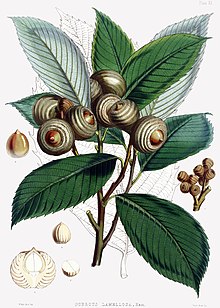Quercus lamellosa
| Quercus lamellosa | |
|---|---|

| |
| 1855 illustration[1] | |
| Scientific classification | |
| Kingdom: | |
| (unranked): | |
| (unranked): | |
| (unranked): | |
| Order: | |
| Family: | |
| Genus: | |
| Species: | Q. lamellosa
|
| Binomial name | |
| Quercus lamellosa Sm. 1819
| |
| Synonyms[2] | |
|
List
| |

Quercus lamellosa(Nepali:फलाँट, Falant) (syn. Cyclobalanopsis lamellosa) is a species of Quercus native to the Himalaya and adjoining mountains from Tibet and Nepal east as far as Guangxi and northern Thailand, growing at altitudes of 1300-2500 m.[3]
Quercus lamellosa is a medium-sized to large evergreen tree growing to 40 m tall with a trunk up to 1.5 m diameter. The leaves are spirally arranged, ovate-elliptic, 16-45 cm long and 6-15 cm broad, with a sharply serrated margin. The flowers are catkins, the female flowers maturing into broad acorns 2-3 cm long and 3-4 cm broad, set in a deep cupule with concentric rings of woody scales.[3][4]
Joseph Dalton Hooker commented,
- "The present is one of the commonest trees about Dorjiling, and is certainly by far the noblest species of Oak known, whether from the size of the foliage or acorns, the texture and colour, or the imposing appearance of the tree." [5]
Quercus lamellosa is occasionally cultivated as an ornamental tree in warm-temperate climates; in the British Isles, cultivation is only successful in the milder parts of Ireland and Cornwall.[6]
References
- ^ illustration from Hooker, Joseph Dalton; Cathcart, John Fergusson; Fitch, Walter Hood: Illustrations of Himalayan plants p.97, plate XX (20)
- ^ The Plant List, Quercus lamellosa Sm.
- ^ a b Flora of China: Cyclobalanopsis lamellosa
- ^ Smith, James Edward in Rees, Abraham 1819. The cyclopædia; or, Universal dictionary of arts, sciences, and literature. vol 29, pages not numbered, alphabetized as Quercus 23
- ^ Illustrations of Himalayan plants : chiefly selected from drawings made for the late J.F. Cathcart, Esq.re of the Bengal Civil Service
- ^ Bean, W. J. (1976). Trees and shrubs hardy in the British Isles, 8th ed. John Murray.
